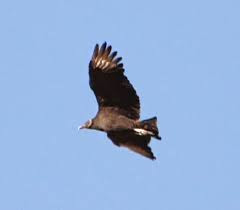 |
| Common merganser male in flight (RE Berg-Andersson) |
It was an interesting article, if you want to learn about "continuous focus mode" and "drive mode" or f-stops and things like that. I do not have that kind of bent. I am of the "point and shoot and hope I'm in focus" school of bird photography.
 |
| Northern harrier (Margo D. Beller) |
Although I never became a professional photographer, some of what I learned has stayed with me. With digital photography you can take literally hundreds of shots a second and sometimes catch what I want. This has been a boon to MH, too, who graduated from my friend's digital camera to a later model that had a faster shutter speed.
So if I am walking along a beach and suddenly a flock of purple sandpipers rears up, I point, hope the automatic shutter focuses on one of the birds and then keep shooting away for at least one good picture. If a black vulture flies over my head and soars in the wind, it is usually easy to get that picture - provided the lens doesn't go into infinity and then I can see nothing.
 |
| Purple sandpipers (Margo D. Beller) |
When the birds sit, even if they fidget, there is a good chance I can get that picture. If they suddenly take off, I can get a great shot or I can get a blur or I can get a picture with no bird at all. If there is a harrier flying close to the ground looking for a meal, I focus on it and follow along and squeeze the shutter again and again.
 |
| Black vulture (RE Berg-Andersson) |
It is for that reason why birds such as the passenger pigeon became extinct. It is why a rich woman had to buy what is now the Hawk Mountain sanctuary to stop local farmers and others from climbing to the top and shooting raptors out of the sky as they used the warm winds of autumn off the mountain ridges to migrate south.
Now you can identify a bird using your binoculars or telephoto lens, and everyone has a camera if they have a cellphone. You will see people out on the trails "shooting" everything including birds, flowers, themselves. The professional bird photographers are still out there with their big lenses and tripods wrapped in cammo as they patiently wait for just the right "shot."
There's money to be made from the right photograph: Calendars. Illustrating articles on how to take pictures of birds.
 |
| Pine warbler (Margo D. Beller) |
But no matter how good my pictures are, I know they will never be as good as the ones in my mind's camera lens.
